|
Those Loveable Flexible Flyers
by
Bob Brooke
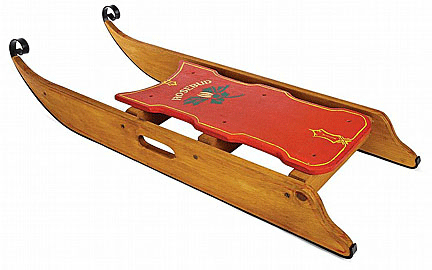 In the opening scene of
the 1941 classic film "Citizen Kane," Charles Foster Kane, newspaper
tycoon, utters his dying word: "Rosebud." But it’s not until the movie
ends that the audience finds out that Rosebud is actually a painted
wooden sled that his mother gave to him as a child, the only possession
that he ever treasured. In the opening scene of
the 1941 classic film "Citizen Kane," Charles Foster Kane, newspaper
tycoon, utters his dying word: "Rosebud." But it’s not until the movie
ends that the audience finds out that Rosebud is actually a painted
wooden sled that his mother gave to him as a child, the only possession
that he ever treasured.
"What puts color in the cheeks and sparkle in the eyes and sets the
whole body tingling with health and happiness? It's coasting!" So read
an advertisement for the Flexible Flyer, America’s Number One sled.
Nothing brings on a bout of nostalgia for 50-something men more than
seeing an old sled. And even the poorest kids knew the joys of sledding
down a snowy hill on a cold winter’s afternoon.
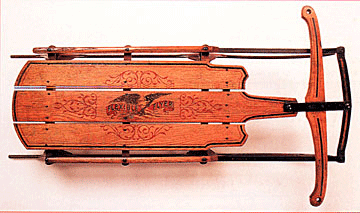 Sleds were the great equalizers. Both rich and poor could enjoy them.
They are the quintessential All-American toy. Words like lightest,
fastest, neatest, cheapest, strongest, most comfortable, and most easily
steered all described the Flexible Flyer and other sleds. To a boy, a
sled was his ticket to cheap and exciting wintertime fun. During the
mid-20th Century, coasting, as boys dubbed the sport, became the winter
pastime of hundreds of thousands of kids living in the snow belt. Sleds were the great equalizers. Both rich and poor could enjoy them.
They are the quintessential All-American toy. Words like lightest,
fastest, neatest, cheapest, strongest, most comfortable, and most easily
steered all described the Flexible Flyer and other sleds. To a boy, a
sled was his ticket to cheap and exciting wintertime fun. During the
mid-20th Century, coasting, as boys dubbed the sport, became the winter
pastime of hundreds of thousands of kids living in the snow belt.
According to legend, sledding began back in Roman times when soldiers
accompanying Julius Caesar in the Alps rode their shields down the snowy
mountainsides, using their spears to steer.
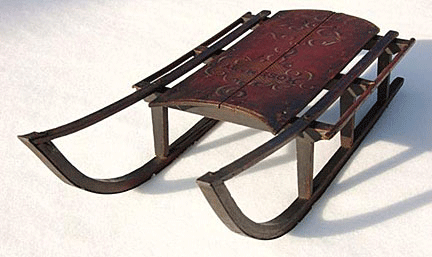 Coasting, as boy’s called sledding, has existed in America since
colonial times. Boston Common was already a favorite sledding hill by
the time of the American Revolution. Coasting, as boy’s called sledding, has existed in America since
colonial times. Boston Common was already a favorite sledding hill by
the time of the American Revolution.
Despite its early beginnings, sledding didn’t get a real boost until the
late 19th century when downhill sledding became an organized sport and
sled design a sophisticated art. Racing was what it was all about. Early
sleds bore names like the Comet, Reliance, Thunder, or Flying Cloud.
In 1861, Henry F. Morton began building sleds as a hobby to make extra
money in his kitchen. He had plans to attend college but suffered
eyestrain from studying, so he took up sled building. His wife, Lucilla,
painted them. The following year, Morton formed the West Sumner
Manufacturing Company. Word of his magnificent hand painted sleds got
out, so he moved his company to Paris Hill, Maine, where he set up
production as the Paris Hill Manufacturing Company.
With the invention of the Flexible Flyer, the first steerable sled, by
Samuel L. Allen in the late 1880s, sledding drastically changed. Allen’s
prominent Philadelphia Quaker parents sent him to the Westtown Boarding
School in Chester County, Pennsylvania, as age 11. After graduation, he
moved to the family farm in 1861 near Westfield, New Jersey, half-way
between Moorestown and Riverton, where he married became a farmer. Soon
he established a company to manufacture farm implements. But since this
was seasonal, Allen needed a product he could make in the summer and
sell in the winter. He decided to make sleds.
 Allen’s first sled, known as the "Fairy Coaster," was a double runner
bob sled that held three or four adults. Light and folding easily for
transport, the sled’s runners and supports were made of steel with plush
seats. But at $50.00, it cost too much to sell in quantity. He began
testing his sleds at Westtown School (also known for its part in the
development of the game Monopoly), his alma mater. Allen’s first sled, known as the "Fairy Coaster," was a double runner
bob sled that held three or four adults. Light and folding easily for
transport, the sled’s runners and supports were made of steel with plush
seats. But at $50.00, it cost too much to sell in quantity. He began
testing his sleds at Westtown School (also known for its part in the
development of the game Monopoly), his alma mater.
It wasn’t until he came up with the ideas for a T-shaped runner and
slatted seat, both new concepts at this time, that he made any progress.
After it was proven, Allen called his sled the Flexible Flyer, an
appropriate name because the sled was fast considering its weight and
size and the only steerable sled at the time.
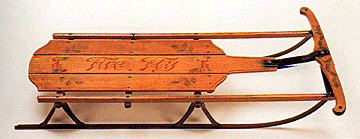 Early sleds, like Rosebud, had no way of steering except for riders to
drag their toes or heels–a bit hard on shoes–or by jerking the sled
sideways. That all changed with the Flexible Flyer. By pulling the
steering arm, a rider could bend the slender steel runners in the
desired direction of travel. And with the ability to steer came
increased speed, achieved by long, straight runners, narrow, with oval
face. Allen obtained flexibility by making the runners of spring steel,
a section of which looks like an inverted tee with a narrow head. By
turning the steering bar, the runners could be curved to the right or
left, thus guiding the sled perfectly, without drag or friction. He
claimed his Flexible Flyer to be the smoothest, strongest, safest sled
made. Early sleds, like Rosebud, had no way of steering except for riders to
drag their toes or heels–a bit hard on shoes–or by jerking the sled
sideways. That all changed with the Flexible Flyer. By pulling the
steering arm, a rider could bend the slender steel runners in the
desired direction of travel. And with the ability to steer came
increased speed, achieved by long, straight runners, narrow, with oval
face. Allen obtained flexibility by making the runners of spring steel,
a section of which looks like an inverted tee with a narrow head. By
turning the steering bar, the runners could be curved to the right or
left, thus guiding the sled perfectly, without drag or friction. He
claimed his Flexible Flyer to be the smoothest, strongest, safest sled
made.
Allen eventually convinced two great department stores, John Wanamaker
in Philadelphia and R.H. Macy in New York, to sell his Flexible Flyers.
By 1915, he was selling 2,000 sleds a day. But what put Allen’s sled
over the top was the interest of the exclusive Tuxedo Club in Tuxedo
Park, New York. Tobogganing was already in vogue at Tuxedo Park when the
New York State Tuxedo Club purchased Allen’s Flexible Flyer sleds.
Coasting at Tuxedo became a major competitive sport, so Allen produced a
sled worthy of its name, "The Tuxedo Racer."
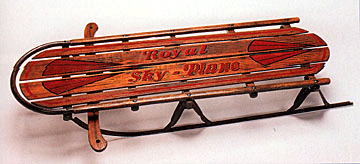 The Racer became the top of the Flexible Flyer line. Allen introduced
the Racer, with its patented grooved runner and "goose neck" bend at the
runner’s front tip, in 1908. Racing sleds didn’t have fancy decoration
like the regular Flexible Flyers. Allen placed a red arrow on his racing
sleds as a symbol of their speed and reduced their weight by a third.
However, a racing sled had longer runners forward of the supports to
give it superior steering capabilities. The Tuxedo Racer was the first
Flexible Flyer to use this high-performance, metal front end, which
Allen added to his entire line in 1915. He also manufactured an economy
sled called the Fire Fly, which had all-wood side rails, an old-style
steering mechanism, and flat runners. The Racer became the top of the Flexible Flyer line. Allen introduced
the Racer, with its patented grooved runner and "goose neck" bend at the
runner’s front tip, in 1908. Racing sleds didn’t have fancy decoration
like the regular Flexible Flyers. Allen placed a red arrow on his racing
sleds as a symbol of their speed and reduced their weight by a third.
However, a racing sled had longer runners forward of the supports to
give it superior steering capabilities. The Tuxedo Racer was the first
Flexible Flyer to use this high-performance, metal front end, which
Allen added to his entire line in 1915. He also manufactured an economy
sled called the Fire Fly, which had all-wood side rails, an old-style
steering mechanism, and flat runners.
By 1917, sled manufacturers like Casper H. Oermann of The American Toy
and Novelty Works in York, Pennsylvania, built their sleds with
hardwoods and nickel plated steel bumpers and grooved runners. Oermann’s
models included the Royal Plane, Royal Racer with spring bumpers,
Monoplane, Speedplane, Snow King, and Eskimo.
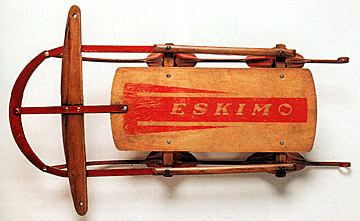 Eusebius B. Garton, who began making his sleds in 1879, in Sheboygan,
Wisconsin, made his sled decks from a special weather resistant
five-layered plywood imported from Finland. He then silk screened
colorful designs, using a brilliant red paint known in the trade as "Garton
Red," on each deck. Eusebius B. Garton, who began making his sleds in 1879, in Sheboygan,
Wisconsin, made his sled decks from a special weather resistant
five-layered plywood imported from Finland. He then silk screened
colorful designs, using a brilliant red paint known in the trade as "Garton
Red," on each deck.
The Garton Toy Company marketed its sleds with the Garton Trademark, but
many retailers contracted with Garton to put their own designs and brand
names over the Garton frame. For instance, the Coast to Coast Apollo
Sled, the Gambles Sled, and Ace Hardware Sled were none other than The
Garton Eskimo, Royal Racer, and the classiest of all, the Silver Streak.
Garton produced 8,500 sleds a week annually from June to Thanksgiving
which was approximately 15 percent of its overall business.
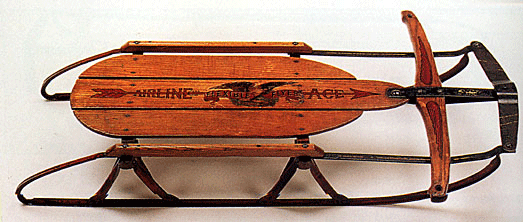
By the 1920s the ability to steer was dominating the market and other
companies began advertising the virtues of their steerable sleds. The
1927 Sears catalog offered the "Flying Arrow." The advertisement read,
"Watch it Fly Around the Corner, these Sleds Really Steer. Runners are
highly tempered spring steel. They curve up abruptly in front, which
leaves more of the long flat runner on the ground, making it easier to
steer and giving a better coasting surface." The price: $2.69, one-third
of that of the Flexible Flyer. During the 1930s, Sears offered "The Snow
Bird," almost exactly the same as the Flying Arrow, now newly improved
to steer the entire length of its runners.
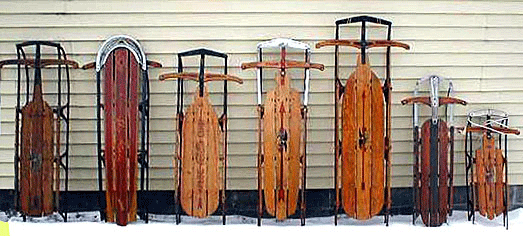
Paris replaced its wooden runners with metal ones in 1912 and introduced
a steering sled called the "Speedway." But it wasn’t until 1920 when the
company switched from a wooden to all-steel frame.
Sleds came in two basic types—clipper and cutters. Designed for boys and
perfect for belly flops, the long and low slung clipper sled had its
deck mounted directly onto low, "squatty" wooden or metal runners which
ended in a point. The rider threw himself on the deck and sped down the
hill head first. Speed was most important.
 More refined and sedate, a cutter’s deck set high on an open framework
above wooden runners. Designed for girls or younger children to ride
sitting up, they were often painted with flowers or dainty motifs with
rounded or bow runners curled elegantly upward in front. Beauty, not
speed, was most important for girls. More refined and sedate, a cutter’s deck set high on an open framework
above wooden runners. Designed for girls or younger children to ride
sitting up, they were often painted with flowers or dainty motifs with
rounded or bow runners curled elegantly upward in front. Beauty, not
speed, was most important for girls.
In1927, The American Toy and Novelty Works merged with the Acme Wagon
Company and became the American Acme Company, Emigsville, Pennsylvania,
producing sleds like the Flexoplane #445, Polar Plane, Speed Plane,
Rocket Plane, Ice Plane, Royal Plane, and Sky Plane.
The Standard Novelty Company of Duncannon, Pa, produced The Racer and
Sno-ball, both non-steerable sleds, and the Lightning Guider. By the
1920s, it had produced more children's sleds than any other American
company. Today, the factory operates as the Old Sled Works, a museum,
antique, and craft center.
<
Back to Antiques Archives
Next Article > |
